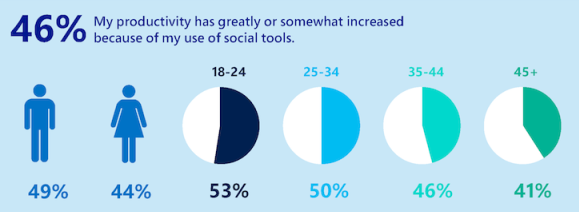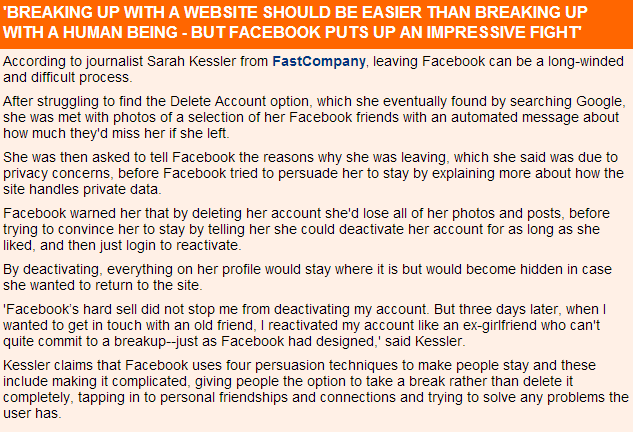It’s becoming increasingly difficult to state that social collaboration tools do not help with office productivity.
The current generation of white-collar workers did not exist in the pre-Internet age, so not using social tools to collaborate seems counter-intuitive. It’s like telling someone in the Iron Age to still use bronze simply because it’s “what they are used to,” despite the fact that iron is far superior in strength.

This infographic comes from a broad Microsoft study conducted across 31 countries and just under 10,000 “information workers.” It’s very interesting to see the statistics don’t differ drastically between ages or genders, but it is curious that despite this evidence, the adoption of social collaboration tools in the workplace is still below 20%.
Amazingly (to me), most people still rely on email as the primary method of communicating, collaborating and sharing. Some apps aim to improve email usage—such as Mailbox for IOS, Sanebox for the Web and K-9 for Android—but they aren’t really efficient unless you receive fewer than 10 emails a day. Answering or eliminating your email inbox has become some type of dark office humour—you’re trying? Ha!
Email is not the fabulous work tool it was in the 1990s. Everyone and anyone can email you now. And only you can sort through it.
No one wants to be responsible for breaking a chain of communication by simply not pressing “CC” or “reply to all.” It’s great that Gmail now checks for attachments if you mention them in your email’s body text—saving everyone from the mortifying failure of a red-faced follow-up email. But for the most part, email is our communication dumping ground. And it’s not enough.
Hootsuite has made a video detailing the extent to which using social tools brings value to the enterprise. Business is about relationships, after all, so it makes sense to use social tools in a workplace environment. However, our damaged trust in social media as a personal tool has damaged the reputation of social collaboration tools for business—before their potential has truly been explored.
Harvard Business Review estimated in 2012 that workers who rely on interactions can expect a 20-25% increase in productivity if they use collaboration tools. Social collaboration generally speeds up many of the little things that slow us down in the workplace, such as getting permission to go ahead with a task and asking quick questions (and having the answers recorded for reference later), but it also provides a real-time overview of the activity of the company as a whole, enabling people to visualize the entire enterprise, not just what’s within their primary sensory capabilities.
Personal vs. Enterprise Social Media

Sarah Kessler’s attempts to delete her Facebook account depicts a kind of sad reality for social media: Many platforms can leave a bad taste in your mouth if you try to break up with them.
Social media users are less concerned about losing privacy—many millennials simply accept that the Internet has made it impossible to hide oneself completely—but controlling what data is collected and used is a high concern. Long-winded and complicated legal statements, like the ones on YouTube, encourage uncertainty. Most people will never read them and get screwed in the future, or will be “smart” about it and never sign up. On top of that, every new platform that uses social logins asks permission to access your data, and pulls the trick of highlighting the “yes” rather than the “skip” button to “post on your behalf” (how kind).
Simply put, not knowing who can see your data is what makes makes people wary of using social media.

Ironically, over 80% of employees use unauthorized apps at work. It seems that once the individual has moved from personal mode to work mode, these concerns fly out the window.
Security still remains the biggest threat to any size business adopting social collaboration in the cloud. But what’s weird is that just 17% of companies say they have fully integrated social collaboration into their business, even though three-quarters have a dedicated social media team. Clearly, there is a lack of understanding on both the employee and employer side of how to handle our impulses—and our fears—to use social media as a tool to make working easier.
Choosing The Right Social Collaboration Tools
Social collaboration tools for the enterprise will go ahead regardless in 2014. But will it be done right?
Social tools for business is a top priority for 2014, according to this McAfee report, which also says the cloud will make it “relatively easy for employees to acquire and deploy SaaS applications without involving the IT department.” This is good news for the many software-as-a-service (SaaS) collaboration solutions out there.
Security matters need to be understood by the average department/team/project manager since the IT experts will be removed little-by-little from the decision process. I’d say this forced learning can only be a good thing. After all, how much thought was really put into securing your enterprise email?
See also: 5 Questions To Ask Before Choosing Your Company’s Social Media Tools
If cloud collaboration solutions are right for your team, you need to find out which specific tool is right for you. Be aware of is how your team works together on a daily basis. The solution you choose should fit smoothly onto their current processes and habits. It should be low friction and enable how they were already working. Trying to impose a tool that functions differently to your team’s natural workflow and communication habits will mean low adoption and eventual abandonment. Researching this will help you make an informed decision, which should lead to greater success at having others adopt the tool.
“We forget at our peril that collaboration is a fundamentally human activity,” said Dion Hinchcliffe, chief strategy officer at Dachis Group. “This implies that any use of enabling technology without taking into account how people actually conduct their work, their inclinations to share information and interact with each other, and in particular how the proposed technology will empower them and alter their collaborative behavior for the better/worse, is bound to disappoint.”
If you can show your team members that their interactions and data are secure, you’ll have a better chance of selling the idea of social collaboration tools to your enterprise. Increasing knowledge about security in the company will ease managers’ worries, too. There is great potential to be harnessed by switching to a collaboration tool solution—the stats prove it and our personal methods and tools for interaction prove it. We are social animals, after all.
Image courtesy of Shutterstock










